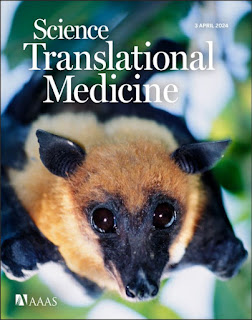Breakthrough Discovery: New Treatment Offers Hope Against Deadly Nipah Virus
Scientists, including alumni and faculty from the Uniformed Services University, have unveiled a groundbreaking treatment using a humanized monoclonal antibody, hu1F5, effectively protecting nonhuman primates against the lethal Nipah virus, marking a significant advancement towards potential clinical use.
 |
(Image credit: Melissa Martin, USU. Photo by National Institute of Allergy and Infectious Diseases, Nipah Virus cell image credit NIAID) |
April 16, 2024 by Ian Neligh
A team of scientists that includes a Uniformed Services University (USU) alumnus and a current faculty member discovered a breakthrough treatment effective in protecting nonhuman primates against the often fatal infection caused by the Nipah virus.
Microbiology and Immunology at USU and others, found the humanized monoclonal antibody known as hu1F5 conferred superior protection to the monoclonal antibody m102.4 when administered to nonhuman primates as late as five days after virus infection, with all hu1F5-treated animals surviving Nipah virus challenge. The publication, “Therapeutic administration of a crossreactive mAb targeting the fusion glycoprotein of Nipah virus protects nonhuman primates,” garnered cover status in the prestigious Science Translational Medicine journal, lending significant validation to the quality and impact of the research. Other collaborative research team members included Dr. Antony Dimitrov, senior scientist at USU’s Department of Microbiology and Immunology (MIC), as well as members from Mapp Biopharmaceutical, the University of Texas Medical Branch (UTMB) and Galveston National Laboratory (GNL), the Uniformed Services University (USU), along with the University of Washington and Vanderbilt University Medical Center. Major support for this research was from a collaborative Center of Excellence for Translational Research (CETR) grant supported by the National Institute of Allergy and Infectious Diseases (NIAID), part of the National Institutes of Health (NIH) to Dr. Broder, Uniformed Services University.Nipah virus is an extremely infectious and lethal disease that can jump from animal to human or even person to person with an up to 90 percent fatality rate. Currently, there are no vaccines or therapies for someone unlucky enough to come in contact with the deadly virus. The Nipah virus and the closely related Hendra virus exist in fruit bats or flying foxes.
The strain of the virus used in the study is known as “Nipah virus-Bangladesh” and it circulates in Indian flying foxes found in India and Bangladesh and is known to be particularly lethal.
“Over the past nearly 15 years,” said Geisbert, the study’s co-corresponding author, “my team in collaboration with the USU lab, along with some of our other colleagues, have conducted and published a host of studies on the therapeutic capacity of m102.4, but here we have shown for the very first time, that this new mAb could protect against fatal Nipah virus-Bangladesh infection, but remarkably can do so even when given the therapy much later after infection. What this means is that as far as people are concerned these latest findings strongly suggest that a potential treatment for Nipah virus infection is at hand.”
According to Broder, “The remarkable success of this new hu1F5 mAb therapy against Nipah virus-Bangladesh infection and disease in a nonhuman primate is a key step towards its further clinical development as an effective therapeutic for use in people.” Broder is one of the study’s co-corresponding authors, and whose laboratory generated the original antibody.
The research demonstrates that the “humanized monoclonal antibody known as hu1F5, which specifically binds to the fusion (F) glycoprotein of both Nipah virus and Hendra virus and prevents virus infection of cells” is effective in protecting against the Nipah virus in animals.
“Right now, there are no other effective therapeutic options for Nipah virus or Hendra virus infection,” said Dr. Larry Zeitlin, cofounder and president of Mapp Biopharmaceutical Inc., and the study’s first and co-corresponding author. “Indeed, in light of these new data on hu1F5, and from our extensive experience in developing mAb-based therapies to highly pathogenic viruses, we are presently working towards taking hu1F5 to the clinic as a new therapeutic option for human Nipah virus infection. We anticipate starting Phase 1 safety testing in human volunteers this year.”
Both the Nipah virus and the Hendra virus appeared in the mid and late 1990s and have since caused outbreaks in both humans and livestock in India, Singapore, Bangladesh, Malaysia and Australia.
“There are currently no licensed and approved vaccines or therapeutics for the prevention or treatment of infection and disease caused by these viruses for use in people,” said Broder. “This human mAb is a highly effective antiviral against Nipah virus, and likely Hendra virus as well, (and) has a real potential as an effective human therapeutic option.”


